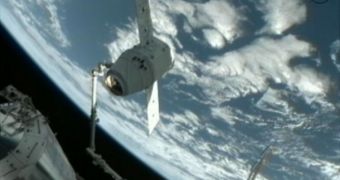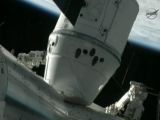At 9:56 am EDT (1356 GMT) yesterday, May 25, the unmanned Dragon space capsule was grappled by the International Space Station's (ISS) Canadarm-2 robotic arm, which was operated by NASA astronaut Donald Pettit.
By 11:52 am EDT (1552 GMT), the privately built spacecraft was attached to the American docking port on the orbital lab's Harmony module. Ten minutes later, NASA astronaut Joseph Acaba announced that all berthing operations were successfully completed.
This event represented the first time that a vehicle built by a private company – the Hawthorne, California-based Space Exploration Technologies Corporation – was allowed to attempt a dock with the $100 billion ISS. The station was built by 5 space agencies and 15 countries over a period of 11 years.
Dragon flew past the station on Thursday, a day ahead of the planned docking attempt, in order to validate key navigation and control systems. Since the maneuver was a success, NASA officials allowed the company to proceed with its plan.
SpaceX took inspiration from the Japan Aerospace Exploration Agency (JAXA) in developing the method by which to dock the Dragon to the space lab. Rather than installing an automated guiding system, the company opted to have their capsule fished from space via a robotic arm.
Expedition 31 crew member and NASA astronaut Donald Pettit was the one responsible for keeping an eye on Dragon's approach, and then using Canadarm-2 to grapple the vehicle mid-flight. He then proceeded to maneuver it into position, on the American-built harmony module.
Dragon took off from the SLC-40 launch pad at the Cape Canaveral Air Force Station (CCAFS) on Tuesday, May 22. It was delivered to low-Earth orbit aboard a SpaceX-built Falcon 9 rocket.
The vehicle will remain attached to the ISS until May 31, when astronauts will detach the connections affixing it to the Harmony module, and then use Canadarm-2 to move the capsule away from the station. The spacecraft will then be let go.
About four hours later, Dragon will begin to reenter Earth's atmosphere, an event scheduled to last about 30 minutes. It will then land safely in the Pacific Ocean, some 402 kilometers (250 miles) off the coasts of California.
The successful docking has far-reaching ramifications for the private space flight industry. Basically, SpaceX demonstrated that NASA spent its money wisely in supporting the private spaceflight sector, and that the agency can continue to do so in the future.
The organization is currently supporting numerous companies in developing both manned and unmanned spacecraft, until its Orion Multi-Purpose Crew Vehicle and Space Launch System are completed. Until then, it will rely on Russian spacecraft for access to space.
“Today marks another critical step in the future of American spaceflight. Now that a US company has proven its ability to resupply the space station, it opens a new frontier for commercial opportunities in space – and new job creation opportunities right here in the US,” NASA Administrator Charles Bolden said.
“By handing off space station transportation to the private sector, NASA is freed up to carry out the really hard work of sending astronauts farther into the solar system than ever before,” he added yesterday.
“The Obama Administration has set us on an ambitious path forward and the NASA and SpaceX teams are proving they are up to the task,” the top NASA official concluded.
SpaceX representatives were equally pleased. The company was founded less than 10 years ago, and already it managed to achieve what few other have. It is currently developing Dragon under a $1.6 billion Commercial Orbital Transportation Services (COTS) contract with NASA.
This was Dragon's second flight ever, and the third for the Falcon 9. The rocket took its maiden flight in June 2010, and then again in December 2010, this time carrying the space capsule.
If the current mission ends well, then SpaceX may begin to fulfill the terms of its COTS contract – which calls for it to carry out 12 resupply flights to the ISS – as early as this autumn. In the mean time, it will continue to develop a manned version of the vehicle.

 14 DAY TRIAL //
14 DAY TRIAL // 
